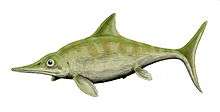Besanosaurus
| Besanosaurus Temporal range: Middle Triassic | |
|---|---|
| | |
| Besanosaurus | |
| Scientific classification | |
| Kingdom: | Animalia |
| Phylum: | Chordata |
| Class: | Sauropsida |
| Subclass: | ?Diapsida |
| Order: | Ichthyopterygia |
| Suborder: | Shastasauria |
| Genus: | Besanosaurus |
| Species | |
| |
Besanosaurus (meaning "Besano [Lombardy, N. Italy] lizard") is a genus of large ichthyosaur (a marine reptile, not a dinosaur) that lived during the middle Triassic period,[1] approximately 235 million years ago. This marine reptile came from the family Shastasauridae and was named by Dal Sasso and Pinna in 1996.[2] The type of species is Besanosaurus leptorhynchus meaning "long-beaked reptile from Besano."[3]
Description

Besanosaurus was a marine reptile nearly 6 meters in length and had a similar shape to dolphins. It had a thin snout, fairly small teeth, no dorsal fin, and a long and straight tail.[3] It was an eel-like swimmer with moderate speed along with rapid acceleration and good maneuvering, and lived in tropical seas, in coastal, and Caribbean-like environments. Besanosaurs were carnivorous and fed mainly on small fish, cephalopods, and marine reptiles.[2] The reptile's reproduction was ovoviviparous,[3] meaning the eggs incubated inside the body and hatched at birth.
Discovery
The bones of Besanosaurus were first discovered in "Sasso Caldo" quarry in the spring of 1993 by the volunteers of the paleontological group of Besano, a small town in the Lombardy region of north Italy. The fossil was almost completely embedded in the rock and could be first seen only through x-rays; to detect the content of the 38 slabs of stone enclosing the skeleton, 145 radiographs were necessary. The skeleton of Besanosaurus came to light in the paleontological laboratory of Museo Civico di Storia Naturale di Milano after 16500 hours of preparation. The preparators removed the rock enclosing the fossil step by step, working under a stereo microscope with chisels, needles and pins. The 38 slabs were reassembled and a silicon rubber matrix was made, from which a cast of the original specimen was obtained.[3]
See also
References
- ↑ "Besanosaurus" Encyclo: online Encyclopedia
- 1 2 "Besanosaurus" Dinosaur and Paleontology Dictionary
- 1 2 3 4 "Besanosaurus: A six-meter-long Icthyosaur from Northern Italy" La Tua Enciclopedia on-line Archived February 20, 2010, at the Wayback Machine.

